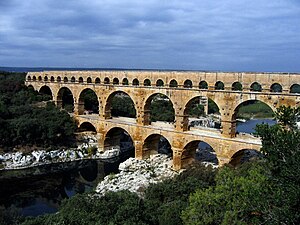Aqueduct
structure constructed to convey water
An aqueduct is a man-made channel that carries water from one place to another. Usually, they are used to supply water to cities and towns. They may also carry water for irrigation, or for hydroelectricity. Pipes, canals, tunnels, and bridges that serve this purpose are all called aqueducts. Some aqueducts carry a canal for boats and ships. The word “aqueduct” comes from the Latin words “aqua” (water) and “ducere” (to lead). Aqueducts have been used since ancient times.[1]

List of major aqueducts
changeAncient Greek aqueducts
change- The Eupalinian aqueduct on the Greek island of Samos.
Roman aqueducts
change- The Pont du Gard in southern France
- Barbegal aqueduct, France
- Eifel aqueduct, Germany
- Caesarea Maritima, Israel
- Kavala, Greece
- Patras, Greece
- Aqueduct of Segovia, Spain
- Acueducto de los Milagros, Mérida, Spain
- Tarragona, Spain
- Almuñécar, Spain (5 aqueducts - 4 still in use)
- Valens aqueduct, Istanbul, Turkey
- Aqua Augusta, Italy
- Aqua Claudia and the Anio Novus, as part of the Porta Maggiore, Rome, Italy
- Skopje aqueduct, Skopje, North Macedonia
Other aqueducts
change- Wignacourt Aqueduct, Malta. Built in the 16th century to transport water from the old capital city of Malta, Mdina to the new capital city Valletta. Today, only part is visible in the localities of Balzan, Birkirkara and Santa Venera.
- Aqueduct St-Clément, Montpellier, France - 17th century
- Águas Livres Aqueduct, in Lisbon, Portugal (built 1731-1748)
- Carioca aqueduct in Rio de Janeiro, Brazil (built 1744-1750)
- Aqueduct of Teruel, Spain
- Roquefavour aqueduct, France - built between 1842 and 1847
- Winnipeg aqueduct, Manitoba, Canada - built between 1915 and 1919
- Canal de l'aqueduc, Quebec, Canada
- Päijänne water Tunnel, a 120 kilometer long underground aqueduct (continuous tunnel) connecting lake Päijänne to Greater Helsinki.
- Wan Mat Saman aqueduct, Kedah, Malaysia - built between 1900 and 1909
- Mathur aqueduct in Tamil Nadu state, India
- Surviving Spanish aqueducts in Mexico:
- Aqueduct of Querétaro, Mexico - built between 1726 and 1738, 1.3 km long and featuring 74 arches.
- Aqueduct of Morelia, Michoacan, built between 1735 and 1738.
- Aqueduct of Acámbaro, Guanajuato, built in 1528 [1] Archived 2007-09-27 at the Wayback Machine.
- Levadas, 1,350 miles (2,170 km) of 17th century aqueducts on the Portuguese island of Madeira.
- Espada aqueduct, built 1735, in San Antonio, Texas, United States.
- Quabbin aqueduct, 24.6 miles (39.6 km) long tunnel, in Massachusetts, United States.
- Chicopee Valley aqueduct, 13.1 miles (21.1 km) long, in Massachusetts, United States.
- Central Arizona Project Aqueduct
- California aqueduct, a 714 mile long combination of canals, pipelines and tunnels, in the Central Valley of the United States.
- Delaware aqueduct, in New York State, United States - at 85 miles (137 km) long, the world's longest continuous underground tunnel.
- High Bridge, part of the former Croton Aqueduct, built in 1848, is the oldest surviving bridge in New York City.
References
changeWikimedia Commons has media related to Aqueduct.
- ↑ "aqueduct", Britannica CD 2000